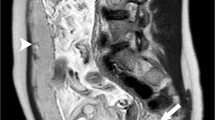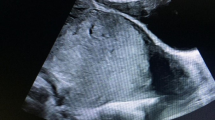Abstract
Purpose
The aim of the study was to evaluate the characteristic imaging features and performance of prenatal magnetic resonance (MR) imaging in the diagnosis of placental invasion.
Methods
This retrospective study was approved by our institutional review board and written informed consent was waived. Twenty-eight patients (age range 26–39 years; mean age, 33.8 ± 3.1 years) with suspected placental invasion underwent prenatal MR imaging, including 7 patients with placental invasion and 21 without. Two radiologists assessed the presence of seven previously described MR imaging findings associated with placental invasion. Sensitivity, specificity, positive and negative predictive values, and accuracy were calculated. The diagnostic performance was also determined by a receiver-operating-characteristic curve analysis.
Results
Three MR imaging findings (uterine bulging, heterogeneous signal intensity in the placenta on T2-weighted images, and hypointense intraplacental bands on T2-weighted images) were significantly more common in patients with placental invasion than in those without (P = 0.020–0.023). The presence of at least two of these three imaging findings yielded a sensitivity, specificity, positive and negative predictive values, and accuracy of 100, 86, 67, 95, and 89%, respectively.
Conclusions
The presence of at least two of the three characteristic prenatal MR imaging findings strongly supports a diagnosis of placental invasion.



Similar content being viewed by others
References
Derman AY, et al. (2011) MRI of placenta accreta: a new imaging perspective. Am J Roentgenol 197(6):1514–1521
Lax A, et al. (2007) The value of specific MRI features in the evaluation of suspected placental invasion. Magn Reson Imaging 25(1):87–93
Baughman WC, Corteville JE, Shah RR (2008) Placenta accreta: spectrum of US and MR imaging findings. Radiographics 28(7):1905–1916
Silver RM, et al. (2006) Maternal morbidity associated with multiple repeat cesarean deliveries. Obstet Gynecol 107(6):1226–1232
Usta IM, et al. (2005) Placenta previa-accreta: risk factors and complications. Am J Obstet Gynecol 193(3 Pt 2):1045–1049
Lau WC, Fung HY, Rogers MS (1997) Ten years experience of caesarean and postpartum hysterectomy in a teaching hospital in Hong Kong. Eur J Obstet Gynecol Reprod Biol 74(2):133–137
Grobman WA, et al. (2007) Pregnancy outcomes for women with placenta previa in relation to the number of prior cesarean deliveries. Obstet Gynecol 110(6):1249–1255
Miller DA, Chollet JA, Goodwin TM (1997) Clinical risk factors for placenta previa-placenta accreta. Am J Obstet Gynecol 177(1):210–214
Martin JA, et al. (2003) Births: final data for 2002. Natl Vital Stat Rep 52(10):1–113
Clark SL, Koonings PP, Phelan JP (1985) Placenta previa/accreta and prior cesarean section. Obstet Gynecol 66(1):89–92
Hamilton BE, et al. (2013) Annual summary of vital statistics: 2010–2011. Pediatrics 131(3):548–558
Wu S, Kocherginsky M, Hibbard JU (2005) Abnormal placentation: twenty-year analysis. Am J Obstet Gynecol 192(5):1458–1461
Lam G, Kuller J, McMahon M (2002) Use of magnetic resonance imaging and ultrasound in the antenatal diagnosis of placenta accreta. J Soc Gynecol Investig 9(1):37–40
Fejgin MD, et al. (1993) Ultrasonic and magnetic-resonance-imaging diagnosis of placenta-accreta managed conservatively. J Perinat Med 21(2):165–168
Maldjian C, et al. (1999) MRI appearance of placenta percreta and placenta accreta. Magn Reson Imaging 17(7):965–971
Kim JA, Narra VR (2004) Magnetic resonance imaging with true fast imaging with steady-state precession and half-Fourier acquisition single-shot turbo spin-echo sequences in cases of suspected placenta accreta. Acta Radiol 45(6):692–698
Breen JL, et al. (1977) Placenta accreta, increta, and percreta. A survey of 40 cases. Obstet Gynecol 49(1):43–47
Author information
Authors and Affiliations
Corresponding author
Rights and permissions
About this article
Cite this article
Noda, Y., Kanematsu, M., Goshima, S. et al. Prenatal MR imaging diagnosis of placental invasion. Abdom Imaging 40, 1273–1278 (2015). https://doi.org/10.1007/s00261-014-0281-z
Published:
Issue Date:
DOI: https://doi.org/10.1007/s00261-014-0281-z




